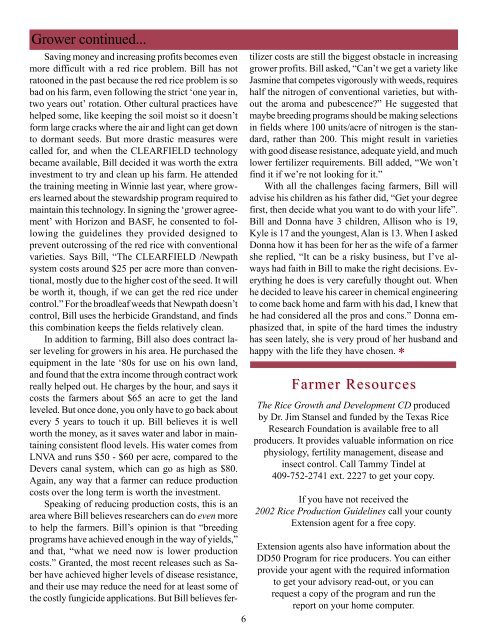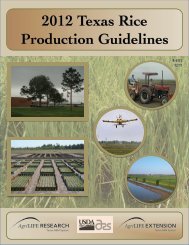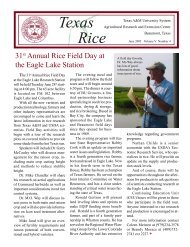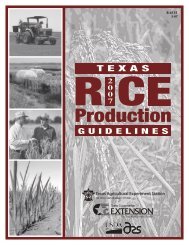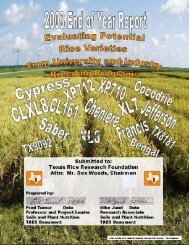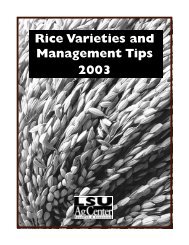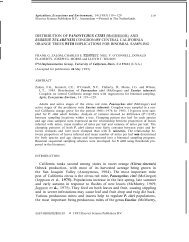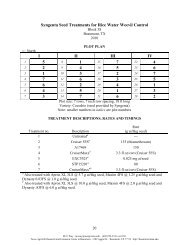Texas Rice - Texas A&M AgriLIFE Research Center at Beaumont ...
Texas Rice - Texas A&M AgriLIFE Research Center at Beaumont ...
Texas Rice - Texas A&M AgriLIFE Research Center at Beaumont ...
Create successful ePaper yourself
Turn your PDF publications into a flip-book with our unique Google optimized e-Paper software.
Grower continued...<br />
6<br />
Saving money and increasing profits becomes even<br />
more difficult with a red rice problem. Bill has not<br />
r<strong>at</strong>ooned in the past because the red rice problem is so<br />
bad on his farm, even following the strict ‘one year in,<br />
two years out’ rot<strong>at</strong>ion. Other cultural practices have<br />
helped some, like keeping the soil moist so it doesn’t<br />
form large cracks where the air and light can get down<br />
to dormant seeds. But more drastic measures were<br />
called for, and when the CLEARFIELD technology<br />
became available, Bill decided it was worth the extra<br />
investment to try and clean up his farm. He <strong>at</strong>tended<br />
the training meeting in Winnie last year, where growers<br />
learned about the stewardship program required to<br />
maintain this technology. In signing the ‘grower agreement’<br />
with Horizon and BASF, he consented to following<br />
the guidelines they provided designed to<br />
prevent outcrossing of the red rice with conventional<br />
varieties. Says Bill, “The CLEARFIELD /Newp<strong>at</strong>h<br />
system costs around $25 per acre more than conventional,<br />
mostly due to the higher cost of the seed. It will<br />
be worth it, though, if we can get the red rice under<br />
control.” For the broadleaf weeds th<strong>at</strong> Newp<strong>at</strong>h doesn’t<br />
control, Bill uses the herbicide Grandstand, and finds<br />
this combin<strong>at</strong>ion keeps the fields rel<strong>at</strong>ively clean.<br />
In addition to farming, Bill also does contract laser<br />
leveling for growers in his area. He purchased the<br />
equipment in the l<strong>at</strong>e ‘80s for use on his own land,<br />
and found th<strong>at</strong> the extra income through contract work<br />
really helped out. He charges by the hour, and says it<br />
costs the farmers about $65 an acre to get the land<br />
leveled. But once done, you only have to go back about<br />
every 5 years to touch it up. Bill believes it is well<br />
worth the money, as it saves w<strong>at</strong>er and labor in maintaining<br />
consistent flood levels. His w<strong>at</strong>er comes from<br />
LNVA and runs $50 - $60 per acre, compared to the<br />
Devers canal system, which can go as high as $80.<br />
Again, any way th<strong>at</strong> a farmer can reduce production<br />
costs over the long term is worth the investment.<br />
Speaking of reducing production costs, this is an<br />
area where Bill believes researchers can do even more<br />
to help the farmers. Bill’s opinion is th<strong>at</strong> “breeding<br />
programs have achieved enough in the way of yields,”<br />
and th<strong>at</strong>, “wh<strong>at</strong> we need now is lower production<br />
costs.” Granted, the most recent releases such as Saber<br />
have achieved higher levels of disease resistance,<br />
and their use may reduce the need for <strong>at</strong> least some of<br />
the costly fungicide applic<strong>at</strong>ions. But Bill believes fertilizer<br />
costs are still the biggest obstacle in increasing<br />
grower profits. Bill asked, “Can’t we get a variety like<br />
Jasmine th<strong>at</strong> competes vigorously with weeds, requires<br />
half the nitrogen of conventional varieties, but without<br />
the aroma and pubescence?” He suggested th<strong>at</strong><br />
maybe breeding programs should be making selections<br />
in fields where 100 units/acre of nitrogen is the standard,<br />
r<strong>at</strong>her than 200. This might result in varieties<br />
with good disease resistance, adequ<strong>at</strong>e yield, and much<br />
lower fertilizer requirements. Bill added, “We won’t<br />
find it if we’re not looking for it.”<br />
With all the challenges facing farmers, Bill will<br />
advise his children as his f<strong>at</strong>her did, “Get your degree<br />
first, then decide wh<strong>at</strong> you want to do with your life”.<br />
Bill and Donna have 3 children, Allison who is 19,<br />
Kyle is 17 and the youngest, Alan is 13. When I asked<br />
Donna how it has been for her as the wife of a farmer<br />
she replied, “It can be a risky business, but I’ve always<br />
had faith in Bill to make the right decisions. Everything<br />
he does is very carefully thought out. When<br />
he decided to leave his career in chemical engineering<br />
to come back home and farm with his dad, I knew th<strong>at</strong><br />
he had considered all the pros and cons.” Donna emphasized<br />
th<strong>at</strong>, in spite of the hard times the industry<br />
has seen l<strong>at</strong>ely, she is very proud of her husband and<br />
happy with the life they have chosen.<br />
*<br />
Farmer Resources<br />
The <strong>Rice</strong> Growth and Development CD produced<br />
by Dr. Jim Stansel and funded by the <strong>Texas</strong> <strong>Rice</strong><br />
<strong>Research</strong> Found<strong>at</strong>ion is available free to all<br />
producers. It provides valuable inform<strong>at</strong>ion on rice<br />
physiology, fertility management, disease and<br />
insect control. Call Tammy Tindel <strong>at</strong><br />
409-752-2741 ext. 2227 to get your copy.<br />
If you have not received the<br />
2002 <strong>Rice</strong> Production Guidelines call your county<br />
Extension agent for a free copy.<br />
Extension agents also have inform<strong>at</strong>ion about the<br />
DD50 Program for rice producers. You can either<br />
provide your agent with the required inform<strong>at</strong>ion<br />
to get your advisory read-out, or you can<br />
request a copy of the program and run the<br />
report on your home computer.


